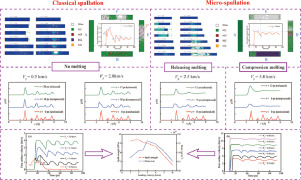当前位置:
X-MOL 学术
›
Mech. Mater.
›
论文详情
Our official English website, www.x-mol.net, welcomes your
feedback! (Note: you will need to create a separate account there.)
Atomic insights into shock-induced spallation of single-crystal aluminum through molecular dynamics modeling
Mechanics of Materials ( IF 3.4 ) Pub Date : 2020-04-01 , DOI: 10.1016/j.mechmat.2020.103343 Liu He , Fang Wang , Xiangguo Zeng , Xin Yang , Zhongpeng Qi
Mechanics of Materials ( IF 3.4 ) Pub Date : 2020-04-01 , DOI: 10.1016/j.mechmat.2020.103343 Liu He , Fang Wang , Xiangguo Zeng , Xin Yang , Zhongpeng Qi

|
Abstract This study investigated on the spalling behavior of single-crystal aluminum under uniaxial impact loading at the micro-scale. Under the framework of non-equilibrium molecular dynamics, the influences of impact velocity on dynamic damage evolution were comprehensively studied. The radial distribution function revealed that the material melted or partially melted when Vp was greater than 2.0 km/s; thus, the impact velocity was used as an indicator to make a distinction between releasing melting (2.0 km/s 4.0 km/s). It was found that the spallation behavior could be characterized by void nucleation, growth, and coalescence. However, the mechanism of void nucleation and growth during classical spallation was completely different from that in micro-spallation. The former was mainly accompanied by the accumulation of countable void nucleation and growth, and consequently, the duration of the spalling process was longer. On the contrary, the micro-spallation of single-crystal aluminum was dependent on a substantial amount of void nucleations; thereby, the fracture time was less. In addition, the dependence of spallation on high strain-rate history was explored. Furthermore, the free surface velocity was determined to predict the spall strength, and it was observed that strain rate and temperature had significant effects on the spall strength. Therefore, the obtained results highlight the efficiency of the proposed analytical model for characterizing the spalling response of single-crystal aluminum induced under uniaxial impact loading.
中文翻译:

通过分子动力学建模对冲击引起的单晶铝散裂的原子洞察
摘要 本研究在微观尺度上研究了单晶铝在单轴冲击载荷下的剥落行为。在非平衡分子动力学框架下,综合研究了冲击速度对动态损伤演化的影响。径向分布函数表明,当Vp大于2.0km/s时,材料熔化或部分熔化;因此,撞击速度被用作区分释放熔化(2.0 km/s 4.0 km/s)的指标。发现散裂行为的特征在于空隙成核、生长和聚结。然而,经典散裂过程中空隙成核和生长的机制与微散裂过程中的完全不同。前者主要伴随着可数空洞的成核和生长的积累,因此剥落过程的持续时间更长。相反,单晶铝的微观剥落依赖于大量的空隙成核;因此,断裂时间较短。此外,还探讨了散裂对高应变率历史的依赖性。此外,确定自由表面速度来预测剥落强度,观察到应变速率和温度对剥落强度有显着影响。因此,获得的结果突出了所提出的分析模型的效率,用于表征在单轴冲击载荷下引起的单晶铝的剥落响应。剥落过程的持续时间更长。相反,单晶铝的微观剥落依赖于大量的空隙成核;因此,断裂时间较短。此外,还探讨了散裂对高应变率历史的依赖性。此外,确定自由表面速度来预测剥落强度,观察到应变速率和温度对剥落强度有显着影响。因此,获得的结果突出了所提出的分析模型的效率,用于表征在单轴冲击载荷下引起的单晶铝的剥落响应。剥落过程的持续时间更长。相反,单晶铝的微观剥落依赖于大量的空隙成核;因此,断裂时间较短。此外,还探讨了散裂对高应变率历史的依赖性。此外,确定自由表面速度来预测剥落强度,观察到应变速率和温度对剥落强度有显着影响。因此,获得的结果突出了所提出的分析模型的效率,用于表征在单轴冲击载荷下引起的单晶铝的剥落响应。探讨了散裂对高应变率历史的依赖性。此外,确定自由表面速度来预测剥落强度,观察到应变速率和温度对剥落强度有显着影响。因此,获得的结果突出了所提出的分析模型的效率,用于表征在单轴冲击载荷下引起的单晶铝的剥落响应。探讨了散裂对高应变率历史的依赖性。此外,确定自由表面速度来预测剥落强度,观察到应变速率和温度对剥落强度有显着影响。因此,获得的结果突出了所提出的分析模型的效率,用于表征在单轴冲击载荷下引起的单晶铝的剥落响应。
更新日期:2020-04-01
中文翻译:

通过分子动力学建模对冲击引起的单晶铝散裂的原子洞察
摘要 本研究在微观尺度上研究了单晶铝在单轴冲击载荷下的剥落行为。在非平衡分子动力学框架下,综合研究了冲击速度对动态损伤演化的影响。径向分布函数表明,当Vp大于2.0km/s时,材料熔化或部分熔化;因此,撞击速度被用作区分释放熔化(2.0 km/s 4.0 km/s)的指标。发现散裂行为的特征在于空隙成核、生长和聚结。然而,经典散裂过程中空隙成核和生长的机制与微散裂过程中的完全不同。前者主要伴随着可数空洞的成核和生长的积累,因此剥落过程的持续时间更长。相反,单晶铝的微观剥落依赖于大量的空隙成核;因此,断裂时间较短。此外,还探讨了散裂对高应变率历史的依赖性。此外,确定自由表面速度来预测剥落强度,观察到应变速率和温度对剥落强度有显着影响。因此,获得的结果突出了所提出的分析模型的效率,用于表征在单轴冲击载荷下引起的单晶铝的剥落响应。剥落过程的持续时间更长。相反,单晶铝的微观剥落依赖于大量的空隙成核;因此,断裂时间较短。此外,还探讨了散裂对高应变率历史的依赖性。此外,确定自由表面速度来预测剥落强度,观察到应变速率和温度对剥落强度有显着影响。因此,获得的结果突出了所提出的分析模型的效率,用于表征在单轴冲击载荷下引起的单晶铝的剥落响应。剥落过程的持续时间更长。相反,单晶铝的微观剥落依赖于大量的空隙成核;因此,断裂时间较短。此外,还探讨了散裂对高应变率历史的依赖性。此外,确定自由表面速度来预测剥落强度,观察到应变速率和温度对剥落强度有显着影响。因此,获得的结果突出了所提出的分析模型的效率,用于表征在单轴冲击载荷下引起的单晶铝的剥落响应。探讨了散裂对高应变率历史的依赖性。此外,确定自由表面速度来预测剥落强度,观察到应变速率和温度对剥落强度有显着影响。因此,获得的结果突出了所提出的分析模型的效率,用于表征在单轴冲击载荷下引起的单晶铝的剥落响应。探讨了散裂对高应变率历史的依赖性。此外,确定自由表面速度来预测剥落强度,观察到应变速率和温度对剥落强度有显着影响。因此,获得的结果突出了所提出的分析模型的效率,用于表征在单轴冲击载荷下引起的单晶铝的剥落响应。











































 京公网安备 11010802027423号
京公网安备 11010802027423号